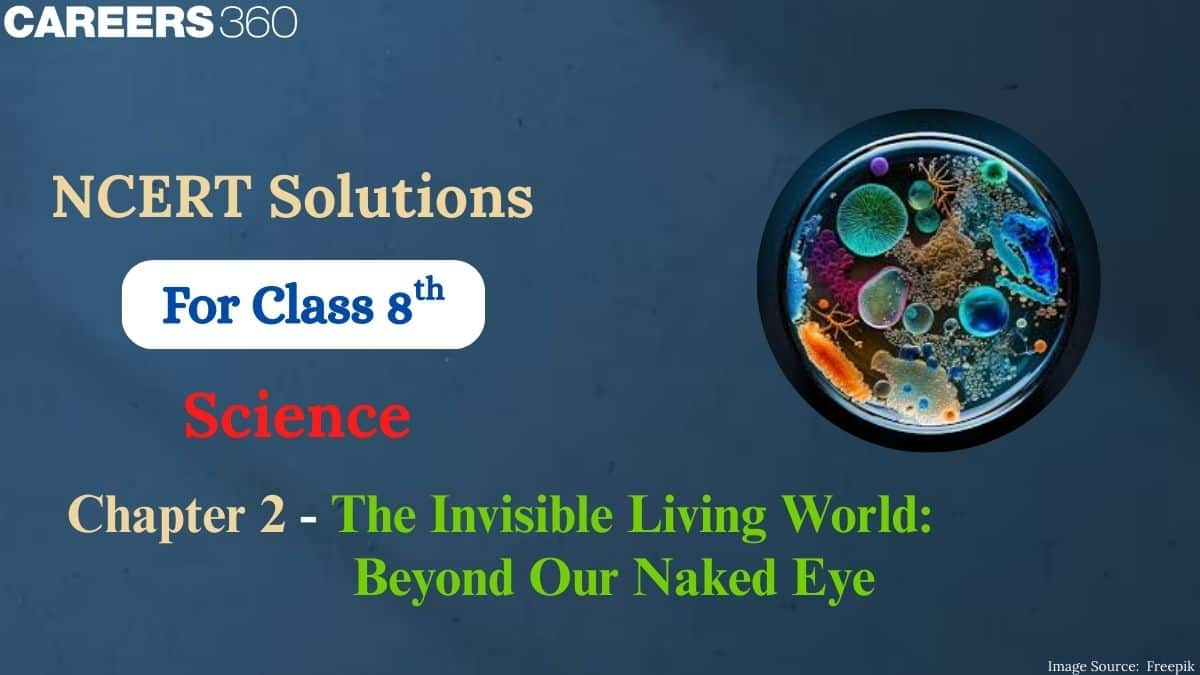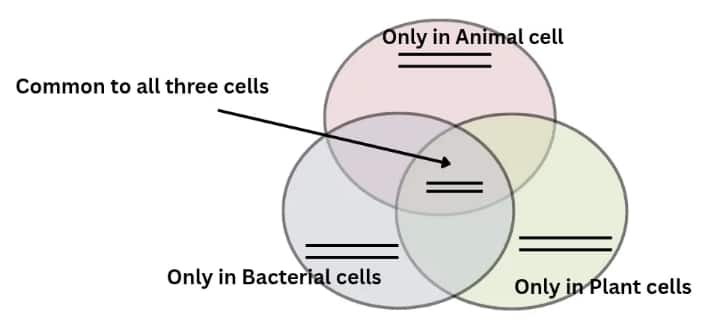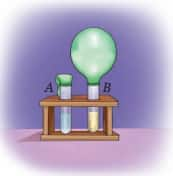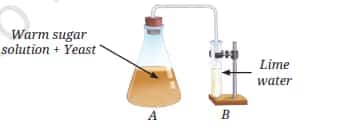NCERT Solutions for Class 8 Science Chapter 2 - The Invisible Living World: Beyond Our Naked Eye
The NCERT Solutions for Class 8 Science Chapter 2 The Invisible Living World: Beyond Our Naked Eye, explain about microorganisms and cells. This chapter introduces different microbes, like bacteria, yeast, fungi, and their uses in the environment and in daily life. Topics such as plant and animal cells, their structure, and the differences between them are also covered. The NCERT Solutions provide a detailed explanation to help students learn and perform well in the exams.
This Story also Contains
- Download The Invisible Living World: Beyond Our Naked Eye Class 8 Questions and Answers PDF
- Get Class 8 Science Chapter 2 The Invisible Living World: Beyond Our Naked Eye Question Answer
- Approach to Solve The Invisible Living World: Beyond Our Naked Eye Class 8 Question Answer
- Important Topics of Chapter 2 NCERT Class 8 Science
- Important Questions from NCERT Class 8 Science Chapter 2
- What You Will Learn From The Invisible Living World: Beyond Our Naked Eye NCERT Solutions
- Why Chapter 2 The Invisible Living World: Beyond Our Naked Eye NCERT Solutions are Important?
- NCERT Solutions for Class 8 Science: Chapter-wise

The Invisible Living World: Beyond Our Naked Eye Class 8 question answers are prepared in simple language by subject experts and include well-labeled diagrams. All the answers follow the latest NCERT guidelines, so students don’t miss anything. This chapter is important as it provides complete knowledge about microorganisms, their uses, and their harmful effects. The Invisible Living World: Beyond Our Naked Eye Class 8 questions and answers PDF lays a strong foundation for higher classes and helps students build clear concepts about organisms.
Download The Invisible Living World: Beyond Our Naked Eye Class 8 Questions and Answers PDF
The PDF for this chapter can be downloaded from the link given below for effective learning. Students can use the Invisible Living World: Beyond Our Naked Eye Class 8 questions and answers PDF anytime for revision and completing homework. The NCERT Solutions for Class 8 are prepared in simple language to help students understand all concepts clearly.
Get Class 8 Science Chapter 2 The Invisible Living World: Beyond Our Naked Eye Question Answer
The detailed answers to all the textbook questions are given below. These solutions are useful for quick revision before exams. Studying through the Class 8 Science Chapter 2 The Invisible Living World: Beyond Our Naked Eye question answer helps students know more about microorganisms.
Question 1: Various parts of a cell are given below. Write them in the appropriate places in the following diagram.

Nucleus
Cytoplasm
Chloroplast
Cell wall
Cell membrane
Nucleoid
Answer:
Only in an Animal Cell | Only in the Plant Cell | Only in the Bacterial Cell | In the Plant and the Animal Cell | In a Plant and in a Bacterial cell | Common to all three cells |
|
|
|
|
| |
|
Question 2: Anandi took two test tubes and marked them A and B. She put two spoonfuls of sugar solution in each of the test tubes. In test tube B, she added a spoonful of yeast. Then she attached two incompletely inflated balloons to the mouth of each test tube. She kept the setup in a warm place, away from sunlight.

(i) What do you predict will happen after 3–4 days? She observed that the balloon attached to test tube B was inflated. What can be a possible explanation for this?
(a) Water evaporated in test tube B and filled the balloon with the water vapour.
(b) The warm atmosphere expanded the air inside test tube B, which inflated the balloon.
(c) Yeast produced a gas inside test tube B, which inflated the balloon.
(d) Sugar reacted with warm air, which produced gas, eventually inflating the balloon.
Answer: The correct answer is option (c) Yeast produced a gas inside the test tube B, which inflated the balloon.
Explanation: Yeast is a type of microorganism, and it belongs to the group of fungi. Like other living organisms, yeast respires and breaks down food to release energy. During this process, it releases carbon dioxide gas, which gets trapped in the balloon and causes inflation.
(ii) She took another test tube, 1/4 filled with lime water. She removed the balloon from test tube B in such a manner that the gas inside the balloon did not escape. She attached the balloon to the test tube with lime water and shook it well. What do you think she wants to find out?
Answer: By doing this experiment, Anandi wants to find out which gas is released by the yeast. The gas, which is trapped in the balloon, when released in the lime water, makes the lime water milky. And if the lime water turns milky, it proves that the gas produced is carbon dioxide (CO2).
Question 3: A farmer was planting wheat crops in his field. He added nitrogen-rich fertiliser to the soil to get a good yield of crops. In the neighbouring field, another farmer was growing bean crops, but she preferred not to add nitrogen fertiliser to get healthy crops. Can you think of the reasons?
Answer: Roots of certain plants, such as beans, have root nodules that contain Rhizobium bacteria. These bacteria trap the nitrogen from the air and convert it into a form that plants can use. This naturally increases the level of nitrogen in the soil, and that’s why these plants do not need nitrogen fertilisers.
Question 4: Snehal dug two pits, A and B, in her garden. In pit A, she put fruit and vegetable peels and mixed them with dried leaves. In pit B, she dumped the same kind of waste without mixing it with dried leaves. She covered both the pits with soil and observed after 3 weeks. What is she trying to test?
Answer: Snehal is trying to test how the presence of dried leaves affects the process of decomposition.
Dried leaves balance the content of dry and wet waste and make the decomposition process faster. On the other hand, in pit B, without dried leaves, the waste remains wet for a long time. This makes the process of decomposition slow.
Question 5: Identify the following microorganisms:
(i) I live in every kind of environment, and inside your gut.
(ii) I make bread and cakes soft and fluffy.
(iii) I live in the roots of pulse crops and provide nutrients for their growth.
Answer:
(i) I live in every kind of environment, and inside your gut - Bacteria
(ii) I make bread and cakes soft and fluffy - Yeast
(iii) I live in the roots of pulse crops and provide nutrients for their growth - Rhizobium
Question 6: Devise an experiment to test that microorganisms need optimal temperature, air, and moisture for their growth.
Answer: Given below is an experiment to test that microorganisms need an optimal temperature, air, and moisture for their growth.
Things Required
3 small glass jars
Cooked rice
Water spray bottle
Jars | Experiment | Observation |
A | Put cooked rice. Cover them and keep them in a warm place. | No growth, as no presence of moisture |
B | Spray a little water on the rice to make it moist. Cover and keep in a warm place. | Show signs of microbes, as this jar has all the optimal conditions |
C | Spray a little water, and keep it in a cold condition, such as a fridge | Very slow growth because the temperature is low in the fridge |
Question 7: Take 2 slices of bread. Place one slice on a plate near the sink. Place the other slice in the refrigerator. Compare after three days. Note your observations. Give reasons for your observations.
Answer: After 3 days, the bread slice placed near the sink shows the growth of microbes such as mould (fungi). While the bread, which is placed in the refrigerator, remains the same.
Reason: Microorganisms like fungi grow faster in warm and moist conditions, which are present near the sink. On the other hand, the temperature of the refrigerator is very low, which slows down the growth of microbes. That’s why the bread stays fresh in the refrigerator for a long time.
Question 8: A student observes that when curd is left out for a day, it becomes more sour. What are two possible explanations for this observation?
Answer: Two possible explanations for this observation are given below:
The curd contains many types of bacteria. One of them is Lactobacillus. When the curd is left out for a day, these bacteria keep multiplying and produce lactic acid, which makes the curd sour.
These Lactobacillus bacteria grow well in warm conditions, resulting in the production of more acid, which makes the curd sour.
Question 9: Observe the set-up given in the diagram and answer the following questions.

(i) What happens to the sugar solution in flask A?
(ii) What do you observe in test tube B after four hours? Why do you think this happened?
(iii) What would happen if yeast were not added to flask A?
Answer:
(i) Yeast, like other organisms, breaks down food to release energy. In flask A, the yeast undergoes the process of fermentation and breaks down the sugar molecules. During this process, it produces carbon dioxide and some alcohol.
(ii) The lime water present in test tube B turns milky after four hours. It happens because the carbon dioxide produced in flask A passes into test tube B. This causes the lime water to be milky.
(iii) If yeast is not added to flask A, then no fermentation occurs, so carbon dioxide will not be produced. As a result, the lime water present in test tube B does not turn milky.
Also, check the NCERT Books and the NCERT Syllabus here
Approach to Solve The Invisible Living World: Beyond Our Naked Eye Class 8 Question Answer
To answer the questions of this chapter, it is important for students to understand the topics. The Invisible Living World: Beyond Our Naked Eye questions and answers introduces tiny organisms and their roles in our lives. Provided below are a few steps that students can follow to answer the questions effectively.
Read the chapter carefully and understand how these microorganisms live around us in different places, like soil, water, and air.
Make a comparison table to know the differences between plant and animal cells. Students can refer to the Class 8 Science Chapter 2 The Invisible Living World: Beyond Our Naked Eye question answer.
Try to understand how cells are discovered and why they are known as the basic unit of life.
Practice remembering definitions and diagrams, such as the structure of cells. Understand the role of microbes in the environment provided in the Class 8 Science The Invisible Living World: Beyond Our Naked Eye question answer.
Solve all the exercises given in the NCERT Solutions for Class 8 Science to check the knowledge and improve problem-solving skills.
Important Topics of Chapter 2 NCERT Class 8 Science
Given below is the list of the important topics from this chapter that will help students revise. For gaining knowledge of these topics, students can refer to the NCERT Solutions for Class 8 Science Chapter 2 The Invisible Living World: Beyond Our Naked Eye.
Cells: The basic unit of life
Discovery of cells and cell structure
Different types of cells
Levels of organisation
Microorganisms
Role of microbes in the environment
Microorganisms and Food
Important Questions from NCERT Class 8 Science Chapter 2
Provided below is an important question that increases the understanding of the concept. To score well in the exam, it is very important to practice questions of different types. For this purpose, students can depend on the NCERT Solutions for Class 8 Science Chapter 2 The Invisible Living World: Beyond Our Naked Eye.
Question 1: The process by which yeast helps in making bread rise is called:
Options
(a) Fermentation
(b) Photosynthesis
(c) Respiration
(d) Decomposition
Answer: The correct answer is option (a), Fermentation
Explanation: Yeast breaks down sugar and produces a gas called carbon dioxide during fermentation. This gas makes the dough rise and become soft and fluffy.
Question 2: Which part of the cell controls all the activities of the cell?
Options:
(a) Cell wall
(b) Nucleus
(c) Cytoplasm
(d) Vacuole
Answer: The correct answer is option (b) Nucleus
Explanation:
The nucleus is known as the control center of the cell. It regulates all the activities of the cell such as growth, reproduction, and metabolism.
Question 3: Which microorganism is used in the production of curd from milk?
Options:
(a) Virus
(b) Fungi
(c) Bacteria
(d) Algae
Answer: The correct answer is option (c) Bacteria
Explanation:
Bacteria like Lactobacillus convert milk into curd by forming lactic acid. This process makes the curd thick and gives it a sour taste.
Question 4: What role do microorganisms play in the production of biogas?
Options:
(a) They purify biogas
(b) They help in the decomposition of waste materials
(c) They remove the foul smell from gas
(d) They cool down the gas
Answer: The correct answer is option (b) They help in the decomposition of waste materials
Explanation:
Anaerobic bacteria break down animal dung and plant waste in the absence of oxygen to produce biogas. This gas mainly contains methane, which is used as a fuel for cooking and lighting in rural areas.
Question 5: Why do microorganisms not infect pickles and murabbas?
Options:
(a) They are cooked well
(b) They are kept in air-tight containers
(c) High salt and sugar content prevent microbial growth
(d) They are made from fruits only
Answer: The correct answer is option (c). High salt and sugar content prevent microbial growth
Explanation:
Pickles and murabbas contain large amounts of salt or sugar, which remove water from the food by osmosis. The lack of moisture prevents microorganisms from growing and spoiling the food, keeping it safe for a longer time.
Question 6: Which microorganism can prepare its own food like plants?
Options:
(a) Bacteria
(b) Algae
(c) Protozoa
(d) Virus
Answer: The correct answer is option (b) Algae
Explanation:
Some microorganisms, like algae, contain chlorophyll and can perform photosynthesis to make their own food. They are found in ponds, lakes, and other water bodies.
Question 7: Which microorganism helps in fixing nitrogen in the soil?
Options:
(a) Rhizobium
(b) Amoeba
(c) Yeast
(d) Plasmodium
Answer: The correct answer is option (a) Rhizobium
Explanation:
Rhizobium is a beneficial bacterium found in the root nodules of leguminous plants. It converts atmospheric nitrogen into forms that plants can absorb and use, helping improve soil fertility.
What You Will Learn From The Invisible Living World: Beyond Our Naked Eye NCERT Solutions
This chapter introduces the tiny organisms that we cannot see with our naked eyes but play a big role in our lives. Apart from this, students learn many interesting facts and things, which are given below:
The role of microbes in food, medicines, and industries is explained clearly in the Invisible Living World: Beyond Our Naked Eye Class 8 question answer.
They will understand what microorganisms are and where they are found in nature.
Students will also learn about plant and animal cells and the differences between them.
They will also learn how to stay safe from harmful microbes and also how to use important ones in everyday life.
The importance of vaccines and antibiotics is explained in Class 8 Science The Invisible Living World: Beyond Our Naked Eye question answer.
Why Chapter 2 The Invisible Living World: Beyond Our Naked Eye NCERT Solutions are Important?
The chapter introduces students to an interesting world of microorganisms that exists all around us. We can see all these organisms with our nakes eye. By going through the Invisible Living World: Beyond Our Naked Eye chapter, students will understand how these tiny organisms play an imporant role in health, environment, and other biological processes.
The solutions are important becuase students will know the concepts of microrganisms and their roles in environment.
The Invisible Living World: Beyond Our Naked Eye chapter chapter builds the base for understanding topics like Viruses, Bacteria, and Protists, which are discussed in detail in Class 12.
The knowledge of microorganisms is also useful while studying Biological Classification and Microbes in Human Welfare in Class 11.
Class 8 Science Chapter 2 The Invisible Living World: Beyond Our Naked Eye NCERT Solutions makes it easier to relate microorganisms with real-world applications.
NCERT Solutions for Class 8 Science: Chapter-wise
Given below are the solution links for all chapters. Students can refer to these to perform well in the exams.
Frequently Asked Questions (FAQs)
The name of the Science textbook for Class 8 is Curiosity. It is prepared in such a way that it encourages students to ask questions, to explore new concepts, and to understand the real-life applications.
The NCERT syllabus of class 8 science includes chapters from physics, chemistry, and biology. It covers topics related to health, microorganisms, electricity, force, solutes, and the nature of matter.
The father of microbiology is Anton van Leeuwenhoek. He was the first person to observe and describe microorganisms using a simple microscope that he made himself.
Microbes are tiny living organisms that cannot be seen with the naked eye and can only be observed under a microscope. They include bacteria, viruses, fungi, protozoa, and algae. Some microbes are useful, like those that help make curd and medicines, while others can cause diseases in humans, animals, and plants.
Certain fungi and bacteria (like Penicillium and Streptomyces) produce substances that inhibit or kill other bacteria. These substances are extracted and purified to make antibiotics.
Improve soil fertility (e.g., nitrogen-fixing bacteria)
Decompose organic waste into compost
Act as biofertilizers and biopesticides
Some bacteria (like Rhizobium) live in the root nodules of legume plants and convert atmospheric nitrogen into a form plants can use, enriching the soil.
Courses After 12th
Applications for Admissions are open.
As per latest syllabus. Physics formulas, equations, & laws of class 11 & 12th chapters
JEE Main Important Chemistry formulas
Get nowAs per latest syllabus. Chemistry formulas, equations, & laws of class 11 & 12th chapters
JEE Main high scoring chapters and topics
Get nowAs per latest 2024 syllabus. Study 40% syllabus and score upto 100% marks in JEE
JEE Main Important Mathematics Formulas
Get nowAs per latest syllabus. Maths formulas, equations, & theorems of class 11 & 12th chapters
